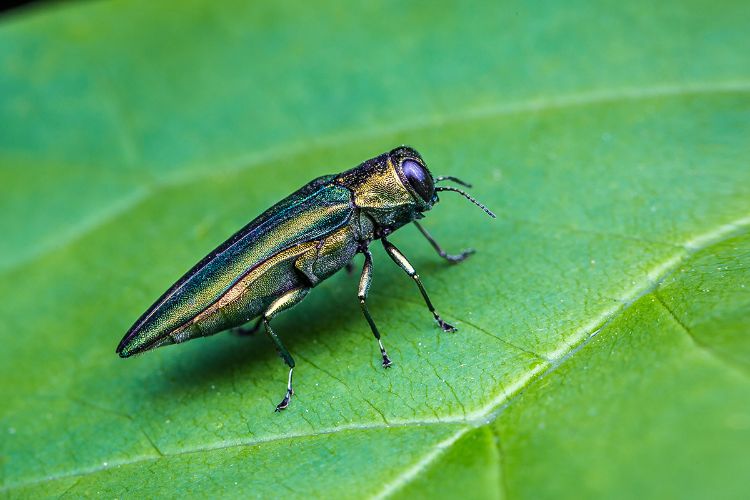EAST LANSING, Mich. — With vibrant and valuable forestry and plant agriculture industries in Michigan, there are a multitude of reasons forest managers and growers want to protect plants.
According to the Michigan Department of Natural Resources (MDNR), forest products create roughly $22 billion in total economic output annually for the state. The Michigan Department of Agriculture and Rural Development (MDARD) reports $753 million as the total economic impact of the Michigan fruit industry, along with $428.2 million for vegetables and $1.26 billion for nursery and landscape crops.
Needless to say, plants are big business in Michigan. So when they are threatened by native and invasive insects, Michigan State University researchers are called upon to assist with the problem.
Using resources from Project GREEEN — Michigan’s plant agriculture initiative through MSU, MDARD and the Plant Coalition — MSU scientists have been addressing emerging and pervasive insect challenges for more than 25 years across an array of plant industries. These preliminary findings have often led to large federal grants from agencies such as the U.S. Forest Service and the U.S. Department of Agriculture’s (USDA) National Institute of Food and Agriculture to further explore the issues.

Deborah McCullough, a professor in the MSU departments of Entomology and Forestry, has been the beneficiary of Project GREEEN funding since the program’s beginnings. One of her initial studies through Project GREEEN focused on emerald ash borer (EAB), which was first discovered in Michigan in 2002 by McCullough and scientists from MDNR, MDARD, and the USDA’s Animal and Plant Health Inspection Service (USDA APHIS).
According to McCullough, EAB has since become the most destructive forest insect to ever invade North America. Hundreds of millions of ash trees have been killed by EAB in the eastern U.S. and Canada, costing cities and private landowners billions of dollars and causing untold ecological damage in forested areas.
“Project GREEEN funding was extremely important to much of our early work with EAB,” said McCullough, whose work is supported in part by MSU AgBioResearch. “This included figuring out basics about the lifecycle and behavior of this insect, which led to evaluating survey and management options. Our preliminary work helped to leverage additional federal dollars, and although EAB is still causing many problems, we’ve been able to offer forest and urban forest managers some tools to deal with it.”
Her initial work involved discovering ways to detect new EAB infestations, comparing the vulnerability of native ash species to EAB, and developing guidelines for protecting ash trees in urban and forested areas. With Project GREEEN funding, she helped create some of the earliest EAB resources for forest managers and the general public.
Roughly a half inch in length, adult EAB shimmer with distinctive metallic-green wings and a shiny purple abdomen. While flashy in appearance, mature beetles are not much of a concern to ash trees as they nibble on leaves. The larvae, however, can cause irreparable injury.
McCullough and other scientists discovered that EAB lay eggs during the summer, which hatch within two weeks. The larvae burrow through the outer bark to feed on the inner bark in distinct serpentine tunnels called galleries. Most ash trees can cope with a few galleries, but as EAB densities build, the larval feeding interferes with the tree’s ability to transport nutrients and water. Branches die, tree canopies become thin, and eventually the entire tree is killed.
As researchers learned more about EAB behavior and activity, McCullough and her team began testing systemic insecticides, including newly developed compounds and application methods. They compared the effectiveness of different products and their ability to protect ash trees over time.

“Unnecessary applications obviously waste money,” McCullough said. “But waiting until the insect has already injured the tree’s vascular system can hinder the chances of success, so it’s a delicate balance.”
Eventually, McCullough and other scientists found that certain compounds applied by injecting the product into the tree base could protect ash trees for up to three years.
Researchers developed recommendations for forest managers and property owners who wished to conserve genetic diversity and slow EAB population growth, as well as arborists who needed to protect individual trees.
Collaborations with economists also showed that protecting landscape ash trees in residential or urban areas with systemic products was less expensive than removing the trees. McCullough said these recommendations continue to be widely used in the 36 states where EAB is established.
More recently, with support from the U.S. Forest Service and others, McCullough, partner researchers and Indigenous groups modeled EAB spread and projected the effects on black ash, the most vulnerable species EAB has encountered.
Results showed that by 2035, 75% of large black ash trees will be dead across most (87%) of their native range. This was coupled with using U.S. Census data to quantify the effect on Indigenous groups that have valued black ash as a cultural resource for generations.
This story was published by AgBioResearch.
